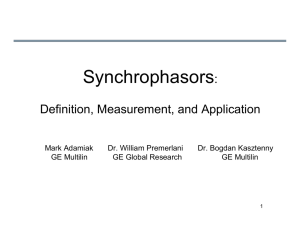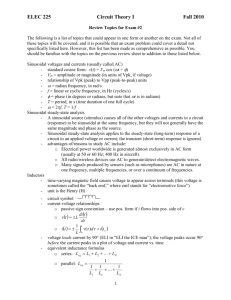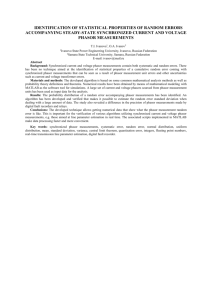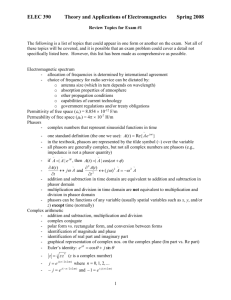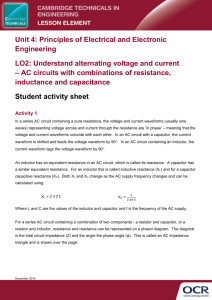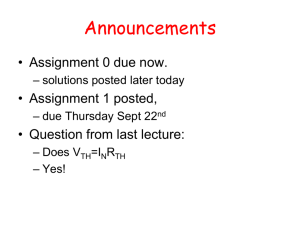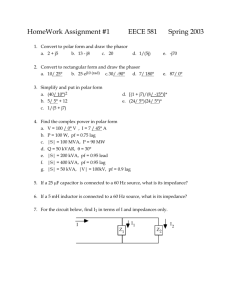review of complex numbers
advertisement
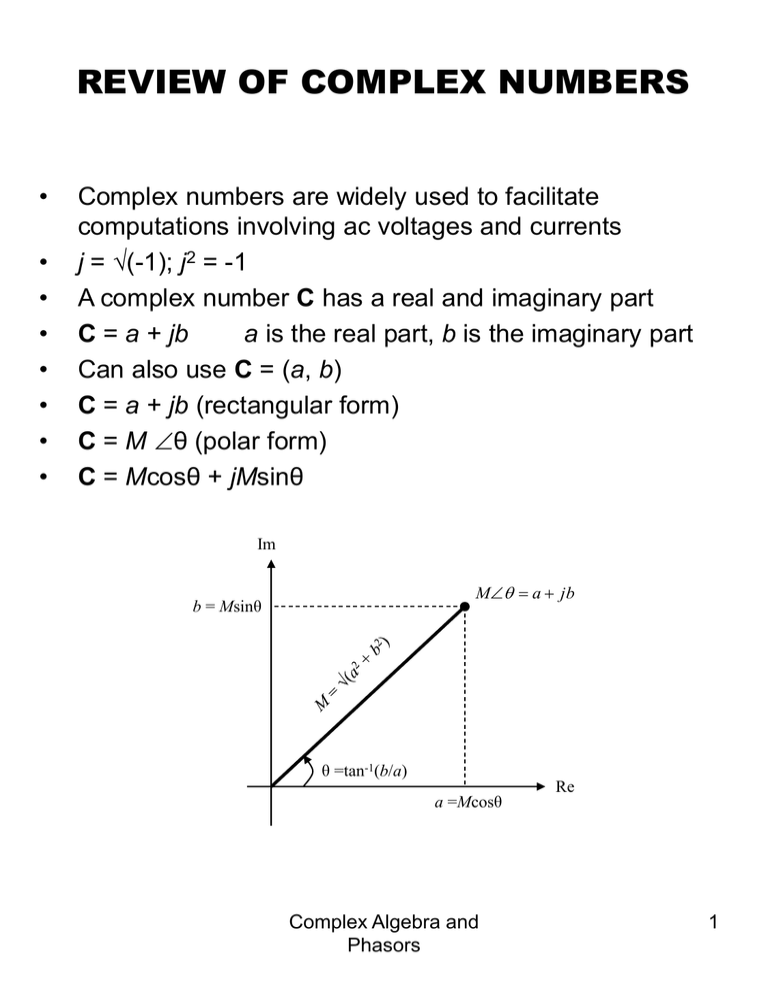
REVIEW OF COMPLEX NUMBERS • • • • • • • • Complex numbers are widely used to facilitate computations involving ac voltages and currents j = (-1); j2 = -1 A complex number C has a real and imaginary part C = a + jb a is the real part, b is the imaginary part Can also use C = (a, b) C = a + jb (rectangular form) C = M θ (polar form) C = Mcosθ + jMsinθ Im M a jb b = Msinθ θ =tan-1(b/a) Re a =Mcosθ Complex Algebra and Phasors 1 ARITHMETIC OPERATIONS • • • • • (a + jb) + (c + jd) = (a + c) + j(b + d) (a + jb) - (c + jd) = (a - c) + j(b - d) Polar form: M11 M 22 M1M 21 2 (a + jb) (c + jd) = (ac – bd) + j(bc + ad) Polar form: M 11 M 1 M 2 2 • • • M2 1 2 Complex conjugate C’ = a – jb = M CC’ = a2 + b2 Special case reciprocal 1/j: 1 10 1 90 j j 190 Complex Algebra and Phasors 2 PHASORS (1) • • • • • A phasor is a mathematical representation of an ac quantity in polar form A phasor can be treated as the polar form of a complex number, so it can be converted to an equivalent rectangular form To represent an ac voltage or current in polar form, the magnitude M is the peak value of the voltage or current The angle θ is the phase angle of the voltage or current Examples: vt 170 sin 377t 40 V 17040 V i t 0.05 sin ωt A 0.050 A vt 10 3 sin 106 t 120 A 10 3 120 V • • The frequency of the phasor waveform does not appear in its phasor representation, because we assume that all voltages and currents in a problem have the same frequency Phasors and phasor analysis are used only in circuit problems where ac waveforms are sinusoidal Complex Algebra and Phasors 3 PHASORS (2) • We can also use phasors to convert waveforms expressed as sines or cosines to equivalent waveforms expressed as cosines and sines respectively Im cos cos (ωt - 30°) =sin(ωt + 60°) -30° 60° Re sin -sin 45° -135° -sin(ωt + 45°) =sin(ωt - 135°) -cos Complex Algebra and Phasors 4 WORKED EXAMPLE • Take the two voltage waveforms: v1 10 sin ω 100 V v2 20 sin ωt 60 2060 V • Converting to rectangular form and adding v1 10cos 0 j sin 0 10 j 0 v2 20cos 60 j sin 60 10 j17.32 v1 v2 20 j17.32 • The polar form of v1 + v2 is 17.32 20 2 17.32 2 tan 1 26.4640.9 20 • Finally converting the polar form to sinusoidal form v1 v2 26.46 sin ωt 40.9 V • Example: Find i1 – i2 if i1 = 1.5sin(377t + 30°) A and i2 = 0.4sin(377t - 45°) A Complex Algebra and Phasors 5 PHASOR FORM OF RESISTANCE • • The voltage v(t) = Vpsin(ωt + θ) V is in phase with the current i(t) = Ipsin(ωt + θ) A when across a resistor By Ohm’s Law R • Converting to phasors we have R • • • • vt V p sin ωt θ i t I p sin ωt θ V p θ I p θ Vp Ip 0 ohms We can regard resistance as a phasor whose magnitude is the resistance in ohms and whose angle is 0° In the complex plane, resistance is a phasor that lies along the real axis The rectangular form of resistance is R + j0 Example: The voltage across a 2.2kΩ resistor is v(t) = 3.96sin(2000t + 50°) V. Use phasors to find the current through the resistor. Draw a phasor diagram showing the voltage and current Complex Algebra and Phasors 6 PHASOR FORM OF CAPACITIVE REACTANCE • • • • The current through a capacitor leads the voltage across it by 90° When v(t) = Vpsin(ωt + θ) V, i(t) = Ipsin(ωt + θ + 90°) A Applying Ohm’s Law for capacitive reactance: v(t) = XCi(t) or V p sin ωt θ vt XC i t I p sin ωt θ 90 • Converting to phasor form XC • • • • V p θ I p θ 90 Vp Ip 90 1 90 ωC Capacitive reactance is regarded as a phasor whose magnitude is |XC| = 1/ωC ohms, whose angle is -90° Capacitive reactance is plotted down the negative imaginary axis The rectangular form is XC = 0 – j|XC| Example: The current through a 0.25F capacitor is i(t) = 40sin(2104t + 20°) mA. Use phasors to find the voltage across the capacitor. Draw a phasor diagram showing the voltage and current Complex Algebra and Phasors 7 PHASOR FORM OF INDUCTIVE REACTANCE • • • The voltage across an inductor leads the current through it by 90° When i(t) = Ipsin(ωt + θ) A, v(t) = Vpsin(ωt + θ + 90°) V Applying Ohm’s Law: v(t) = Xli(t) or XL • Converting so phasor form XL • • • • vt V p sin ωt 90 i t I p sin ωt V p θ 90 I p θ Vp Ip 90 ωL90 Inductive reactance is regarded as a phasor whose magnitude is |XL| = ωL ohms with angle 90° Inductive reactance is plotted up the imaginary axis The rectangular form is XL = 0 + j|XL| Example: The voltage across an 8mH inductor is v(t) = 18sin(2π106t + 40°) V. Use phasors to find the current through the inductor. Draw a phasor diagram showing the voltage and current. Complex Algebra and Phasors 8
